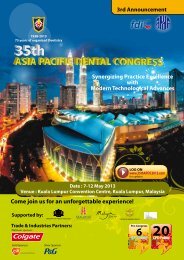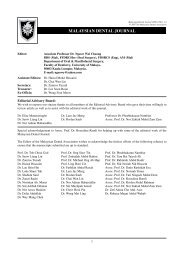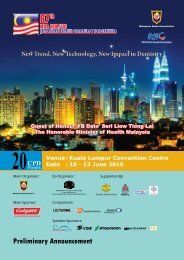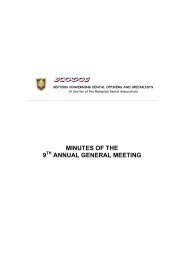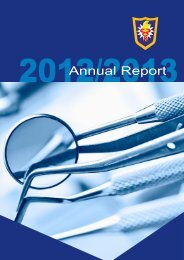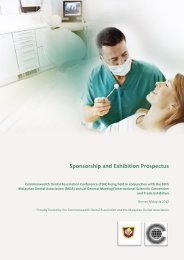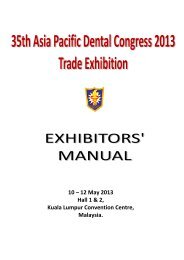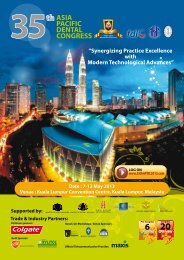PDF( 8mb) - Malaysian Dental Association
PDF( 8mb) - Malaysian Dental Association
PDF( 8mb) - Malaysian Dental Association
You also want an ePaper? Increase the reach of your titles
YUMPU automatically turns print PDFs into web optimized ePapers that Google loves.
Marlynda / Natasyatraining session. During this period of training, it is hopedthat students would develop high self-confidence andcompetence as well as a high level of satisfaction beforethey treat patients in the real clinical setting. It was theaim of this study to evaluate student’s perception, selfevaluation and satisfactory level in preparing duralay burnoutpost in preclinical fixed prosthodontics sessions afterlectures and video demonstrations.MATERIALS AND METHODS1. ParticipantsThe participants comprised of 104 dental students intheir fourth year of undergraduate study. All students hadexperience in dental simulation session in their third yearfor preclinical operative procedures. These sessions wereconducted in Simulation Laboratory Faculty of Dentistry,Universiti Kebangsaan Malaysia (UKM).Before the sessions started, participants were givena preclinical manual consists of diagrams and pictures ofall the procedures that they have to perform, evaluationcriteria and multiple choice questionnaires on theirperformance. The training period consists of two, one-hourlectures per week, each of which is followed by three to sixhours of preclinical laboratory practice time per week. Thislaboratory time specifically focuses on the concepts taughtin the classroom. In addition, a live video demonstration onhow to prepare duralay burn-out post was shown before thestudents started any procedures in simulation laboratory.The students were asked to participate in this study, andwritten consent from them was obtained.At the end of this seven-week period, and aftercompleting and passing all the tasks, the students enteredthe clinic and performed fixed prosthodontics treatment.2. Procedures4th year students had undergone preclinical sessionfor endodontics during the 3rd year and already completedroot canal treatment on single rooted tooth. The same toothwas used for preclinical post and core preparation.Gates Gliddens (DENTSPLY Maillefer, Oklahoma,USA) and Parapost drills (ParaPost®XPTM, Coltene/Whaledent Inc., New Jersey, USA) were used to removeand shape the canals to an appropriate size and depth.The minimum length of the post is equal to the length ofthe clinical crown. The recommended length is two-thirdsthe length of the root in bone while maintaining 5 mm ofgutta-percha at the apex. A second periapical radiograph(KODAK INSIGHT Carestream Health Inc., New York,USA) was taken to confirm adequacy of canal enlargementand the length of gutta percha (DENTSPLY Maillefer,France) apically. Then, they can proceed with preparationof duralay build-up/pattern.First, they need to lubricate the remaining toothstructure with Vaseline (Chesebrough Ponds USA Co.,Connecticut, USA) provided, then the mixed duralay(Reliance <strong>Dental</strong> Mfg. Co, Illinois, USA) was added to theburn-out post (ParaPost®XPTM, Coltene/Whaledent Inc.New Jersey, USA). The completed duralay post and corewere allowed to polymerize. Using diamond bur (Komet,NTI-Kahla GmbH, Kahla, Germany) water and suction,the duralay core was prepared to the shape of an idealcrown preparation in the same manner as a conventionalpreparation.Once completed and satisfied with their work,students were asked to answer the questionnaires inthe preclinical manual. At the end of the preclinical,the students hand in their mounted tooth, radiographs,completed post and core pattern as well as their preclinicalmanual.3. Data CollectionData collection took place on the second week afterthe preclinical sessions ended. The data were processedand analyzed by means of the Statistical Package for theSocial Sciences (SPSS version 12.0).RESULTSFrom 104 fourth year dental undergraduate UKMstudents, only 92 students completed the questionnaire.A. CANAL PREPARATIONQuestion A1: How much of gutta percha did you leaveapically?a. Less than 5mm b. About 5mmc. More than 5mm85 students (92.4%) left the gutta percha around 5mmapically; 6 students (6.5%) admitted to leave the guttapercha more than 5mm while only 1 student (1.1%) leftless than 5mm of gutta percha apically. Refer to Figure 1.Figure 1: Length of gutta percha left apicallyQuestion A2: The canal preparation is,a. Over preparation b. Under preparationc. Nicely shaped129



